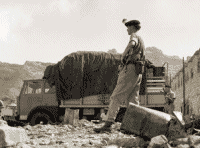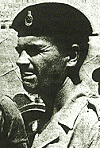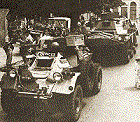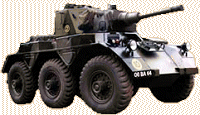The Arab Police Mutiny
20th of June 1967

The South Arabian Army (SAA) had come into existence with the combining of the Federal Army and the Federal Guard. The SAA numbered about 15,000 troops with it's own artillery, armour and engineers. It had been commanded by British officers up until 1967 when, because of the imminent British withdrawal, Arab officers replaced the British officers. Within the ranks of the SAA there were large elements of FLOSY and NLF supporters. During 1967 the British Government was not entirely sure where the SAA loyalties lay.

In June of 1967 Nasser's Egyptian Army took a terrible beating from the Israeli Army during the Six Day War. This Arab defeat strained relations between the Arabs and the British in Aden because the Arabs thought that Britain, along with the United States, had aided Israel. The United States certainly had aided Israel.
The Aden Mutiny began on the night of the 19th of June 1967. Men of The Royal Northumberland Fusiliers were enjoying the film "The Battle of the Bulge" at the cinema when shots were heard. the Fusiliers immediately returned to their barracks at Waterloo Lines and deployed to guard the married quarters. Next morning Arab soldiers based at Lake Lines mutinied and burnt down their barracks.
This mutiny had started because three Arab colonels had been suspended and also because of tribal rivalries with in the SAA. The fire was quickly put out and the colonels reinstated but trouble quickly spread to Champion Lines. Arab soldiers broke into the armory and started fighting each other in tribal groups. Discipline broke down completely and the Arab and British SAA officers locked themselves in the camp guardroom. The Arabs then started firing randomly into the nearby Waterloo Lines where British troops were billeted.
At 9.00am a three-ton truck containing men of 60 Sqn, was returning to Normandy Lines. These troops had just completed weapons training on the local ranges. As the lorry passed the SAA camp they came under heavy machine gun fire from the SAA troops. Eight of the Royal Corps of Transport were killed in this unprovoked attack. The chaplain of the 1st Battalion Lancashire Regiment, Reverend Robin Roe, on hearing the gunfire left Radfan Camp to find out what was happening. On the road outside the SAA camp he found a British army lorry on fire with British bodies scattered around it. Although under heavy fire Reverend Roe bravely helped the wounded survivors back to Radfan Camp. For his brave action in saving the wounded, Reverend Roe was awarded the Military Cross. The SAA now directed their fire into Radfan Camp killing a British officer, 2nd Lieutenant Young of the 1st Battalion Lancashire Regiment. Also two policemen and a public works employee were killed.

The 1st Battalion Lancashire had two other casualties during their tour of Aden. Rod Blenkarn was an NCO from Recce pltn in the turret of a Ferret scout car when a sniper squeezed a round through the open flap Blenkarn was peering out of. Charlie Roberts was fatally wounded by a grenade whilst on a foot patrol.
C Company the 1st Battalion King's Own Royal Border Regiment under the command of Major David Miller was ordered to put down the mutiny using minimum force. C Company set off for Champion Lines accompanied by a troop of the Queens Dragoon Guards in support. As the first British truck entered Champion Lines it came under machine gun fire. One British soldier was killed and 8 wounded. The British NCOs ordered their troops to keep their cool. Even though they could see the bodies of British soldiers lying on the ground, they remained calm. Major Miller sent 10 Platoon to release the officers still hiding in the guardroom.
The officers were rescued without any bloodshed. The Arab soldiers were still taking pot shots at the British as they tried to evacuate the wounded. Cpl. Vickers RCT and Pte. Dickerson of the Kings Own both braved the sniper fire to drive the wounded men back to Radfan Lines. Both Cpl. Vickers and Pte. Dickerson were awarded Mention in Despatches C Company started to advance through Champion Lines disarming the Arab soldiers as they went. No shots were fired and no Arabs killed. The British soldiers kept their heads, their discipline, as well as their courage and won the 1st Battalion King's Own Royal Border Regiment a new battle honour to add to the Regimental flag, "Champion Lines". Major Miller received the Military Cross for his control of the situation on the day.

While all this was taking place around Champion Lines, the Arab Police in the police barracks in Crater started to get nervous. On hearing the shooting, the police thinking that the British would be out for revenge emptied their armoury and took to the roofs of the surrounding buildings of the Police Barracks next to the Queen Arwa Road.
At 11 O'clock a "State Red" warning was giving to the Royal Northumberland Fusiliers who were keeping the peace in Crater. Major Moncur, who was commanding Y Company of the Fusiliers, sent Lieutenant John Davis and his section into Crater in an armoured personnel carrier (a Pig) Davis moved through Crater but noted nothing unusual. Davis returned and reported back to Major Moncur. Shortly afterwards, Davis's section went back into Crater. This time they noticed that the Arabs in Crater had erected some small roadblocks. As the patrol headed towards the Arab Police barracks they saw that some buses had been parked across the Queen Arwa road as a roadblock. Davis and three members of his patrol, including his radio operator, dismounted from the Pig. As soon as the four men left the vehicle they came under heavy fire. Davis ordered the Pig driver to return back Main Pass. The Pig drove off with out Davis and the three other men. This was the last anyone ever saw of these four brave men.
Davis's had been unable to inform Major Moncur that he was under fire, because his radio operator had left the Pig with him and most likely killed shortly after the firing started. Moncur was concerned about Davis's patrol, as he had not heard from them since they entered Crater. On hearing the shots and fearing that Davis was in trouble, Moncur and his escort, Sgt. Maj. Pete Hoare, Fusilier Hoult and Fusilier John Story and two others, jumped into the Majors Land Rover and headed in to Crater up the Queen Arwa road. Major Bryan Malcolm, OC "D" Company of the Argylls, along with Pte. Moores and Hunter followed close behind in another Land Rover. The two Land Rovers drove up the Queen Arwa road not realizing they were driving into a treacherous ambush.

As the two Land Rovers drove past the Arab Police Barracks, the trap was sprung. Without warning the police opened fire with a well planed murderous cross fire. The Land Rovers pulled up and those men who had not already been hit leapt out to fire back. But there was no cover for them and the massacre was soon over. Only one British soldier managed to survive. Fusilier John Storey managed to race across the road to the cover of the flats opposite the Police Barracks without being hit. As he looked back he saw that all the others had been killed apart from one soldier, who was still firing at the Police. Fusilier Storey watched with horror, as the last soldier was machine-gunned down. Later, Storey was unable to identify this man.
Storey got on to the top of the flats and started firing at the Police positions before he had to take cover. He burst into one of the Arab flats and held the occupants at gunpoint for three hours until the Arab Police captured him. He was about to be shot when a senior Arab Police officer ordered his men not to kill him. Storey was tied up and placed in the back of a truck, which he found to his horror, contained the burnt bodies of his dead comrades. He was later released unharmed.
Donavon Slaven writes:
I was on duty at the Medical Centre at RAF Khormaksar when the alarm was raised on 20th June 1967. Prior to the call, during the morning, the airfield had been subjected to small arms fire from the direction of the Aden Police Barracks. Spent rounds could be heard falling around the swimming pool where I was taking a break. A Tannoy broadcast announced that the airfield was under attack and I returned to duty. All that was known to me was that a major incident had occurred in Crater. involving British troops. I travelled in an RAF Vehicle to Main Pass above Crater where I transferred to an army ambulance, with the on duty medical officer Flight Lieutenant Russell-Martin. Press personnel were present at the point of transfer, which gave an indication of the severity of the incident.
In the vehicle there was myself, Dr Russell-Martin, an army medic, an RAF policeman and the ambulance driver. We were escorted into Crater by vehicle with armed men on board with their weapons trained on the ambulance. Being in the back of the vehicle with the army medic, I could not make out what uniform, if any, the occupants of the escorting vehicle were wearing.
On the way in Dr Russell-Martin saw some armed men on rooftops and asked the policeman, who had a Sterling sub machine gun to "cover them". The policeman refused and secreted the weapon either under his seat or the vehicle dashboard. If the weapon had been discovered by our escorts, I feel that the outcome of this journey would have been very different.
We were taken past the vehicles that had been ambushed which were still alight and smoking. We arrived at the Police barracks in Crater and pulled up next to two military trucks. The tail gate of the nearest truck to the ambulance was open and the bodies of the ambushed Northumberland Fusiliers could be seen. They were very bloody and appeared to have been mutilated.
Dr Russell-Martin was escorted into the barracks where he stayed for what seemed to be an interminably long time. During the time that he was inside the barracks, a crowd appeared running from one of the streets from the direction we entered. I alerted the armed police and they took action to disperse the crowd. At this late stage, I cannot recall if shots were indeed fired, but I do remember vividly that weapons were levelled at the crowd which dispersed quickly into the side streets.
Dr Russell-Martin eventually emerged with Trooper Story, the only survivor of the ambush. Dr Russell-Martin attempted to negotiate the removal of the bodies, but was refused. We were escorted back out of Crater to Main Pass where I transferred back to the RAF vehicle. Trooper Story was taken to Steamer Point Hospital by the Army vehicle.
I am sorry but I cannot recall the names of the driver, the RAF policeman or the Army Medic.
For the record, my service details at the time I was in Aden were:- Q0682195 Cpl. Donavon Slaven, Nursing Attendant, RAF Khormaksar. Sept1966-Sept1967

On hearing the shooting 2nd Lt. John Shaw of the the Royal Northumberland Fusiliers volunteered to take his patrol into Crater to see if the Major Moncur need support. His patrol moved into Crater traveling in a Pig supported by two armoured cars, a Saladin and a Ferret of the Queens Dragoon Guards. When Shaw and his patrol arrived at the scene of the ambush they found the two burning Land Rovers with eight bodies littering the road. The Police now opened fire on the Pig and the armoured cars. The fire was so intense that the paint started to flack of the armour inside of the Pig. The men in the Pig returned fire until their ammunition was expended and the tires of the Pig blow out by gun fire.
The Saladin commander radioed for permission to fire his 76 mm gun at the building, but Brigade HQ refused permission. He was told he could only fire his machine gun. Fearing the possibility of being hit with an anti-tank weapon the Saladin had to withdraw along with the Pig and Ferret.

Throughout the day more attempts were made to advance through a hail of police fire on the Police Barracks. Each time permission to use heavy weapons was refused by Brigade. A Sioux helicopter was sent to place some Fusiliers on an OP above Crater. The helicopter was brought down by Police fire but none of the crew or soldiers were killed in the resulting crash.
By the end of the day 22 British soldiers lay dead and Crater was in the hands of an estimated 500-armed Arab terrorists and the Arab Police.
Col. Blenkinsop of the Northumberland Fusiliers and Col. Mitchell of the Argyll Sutherland Highlanders went in person to the Brigade HQ to gain permission to re enter Crater in a combined attack with both battalions and "sort them out " Them being the Arab Police. Brigade refused permission. The decision had been made to seal off Crater and not engage the Police. All exits to Crater were closed and guarded while 45 Commando took up positions on the high ground surrounding Crater. The Royal Northumberland Fusiliers took up positions on inscription Hill above Marine drive. The following day Crp Terry Beal of 9 Plat Y company was wounded in the head by a unknown sniper inside Crater. The bullet hit Cpl Beal just above his right eye. Although few people would have survived this horrendous injury, Cpl Beal was flown back to England and made a remarkable recover.



